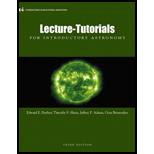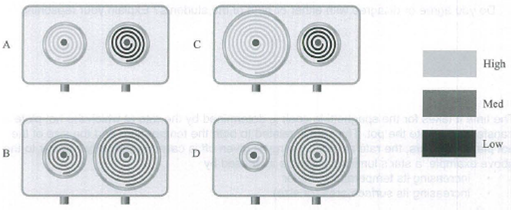
Concept explainers
Imagine you are comparing the ability of electric hot plates of different sizes and temperatures to fully cook two identical large pots of spaghetti. Note that all the pots are as large as the largest hot plate. The shading of each hot plate is used to illustrate its temperature. The darker the shade of gray the cooler the temperature of the hot plate.
If you use two hot plates of different sizes, can you assume that the hot plate that can cook a large pot of spaghetti first is at a higher temperature? Which lettered example above supports your answer?

Learn your wayIncludes step-by-step video

Chapter 3 Solutions
Lecture- Tutorials for Introductory Astronomy
Additional Science Textbook Solutions
Introduction to Electrodynamics
Physics for Scientists and Engineers: A Strategic Approach with Modern Physics (4th Edition)
Conceptual Physical Science (6th Edition)
Essential University Physics: Volume 1 (3rd Edition)
Tutorials in Introductory Physics
- Blackbody objects emit different amounts of different colors of light, depending on how hot they are. For which temperature listed below would a blackbody object look most red to the human eye? Group of answer choices 300 K temperature 3,000 K temperature 5,000 K temperature 7,000 K temperaturearrow_forwarda) To which object corresponds this spectrum to? b) What is the source of radiation for each of the two humps? c) Why does the hump on the right hand side peak at higher wavelength than the hump on the left? [Specifically, what does this tell you about the temperature for each object that the light originates from?]arrow_forwardHelp me pleasearrow_forward
- Explain how we use spectral absorption and emission lines to determine the composition of a gas.arrow_forwardWhat is the wavelength in meters observed with a frequency of (4.5x10^15)? Answer with 2 significant figures and it must be in scientific notation. Note: Your answer is assumed to be reduced to the highest power possible. Your Answer: Answer x10 unitsarrow_forwardQuestion: What gas is contained in a discharge tube?With the equation: λ = sin(θ)/p*n. where p=1/d How will you identify the gas from its visible line spectrum? Clearly describe the method you will use.arrow_forward
- Question 9 Look at the three spectra of stars in the picture above. The top one, for instance, is the darkest at the blue end and the brightest at the red end. Using such considerations, list the top, middle and bottom spectra in order of temperature, highest to lowest.arrow_forwardAs we have been slowly discovering more and more about the atoms we have encountered several different models of the atoms. All of these models have issues. One of the most common issues is the scale of the subatomic particles. Like the image below The proton in this model is too large. Given the following measurement, how many protons would need to set side-by-side to to equal the width of a hydrogen atom? The radius of a proton is 0.5636 fm (Femtometer). The diameter of a hydrogen atom is 7.5 Angstroms. must be written in Scientific noation.arrow_forwardA lightbulb manufacturer makes bulbs with different "color temperatures," meaning that the spectrum of light they emit is similar to a blackbody with that temperature. Assuming the emitting areas of the filaments in two bulbs with color temperatures of 2,000 K and 4,000 K are the same, which of the two is the brighter? About how much brighter is this bulb than its companion?arrow_forward
- Tutorial Star A has a temperature of 5,000 K and Star B has a temperature of 6,000 K. At what wavelengths (in nm) will each of these star's intensity be at its maximum? If the temperatures of the stars increase, the wavelength of maximum intensity. What is the temperature (in K) of a star that appears most intense at a wavelength of 829 nm? Part 1 of 4 Wien's Law tells us how the temperature of a star determines the wavelength of maximum intensity or at what wavelength the star appears brightest. 2.90 x 106 TK If the temperature is in kelvin (K) then A is in nanometers (nm). Anm ^A = AB = = Part 2 of 4 To determine the wavelengths of maximum intensity for the two stars: 2.90 x 106 2.90 x 106 K nm nmarrow_forwardA perfect black body has its surface temperature 27 cº Determine : Maximum radiation wavelength? Black body radiation intensity? The rate of energy released from 2m² Tungsten wire had its radiating surface area 8mm² and its temperature 2100K, considering that the wire is an ideal black body, Calculate the energy that the wire radiates in 10 minutes. Suppose the surface temperature of the Sun were about 12,000K, rather than 6000K. a. How much more thermal radiation would the Sun emit? b. What would happen to the Sun's wavelength of peak emission? c. Do you think it would still be possible to have life on Earth? Explain /A The energy radiated by a black body at 2300K is found to have the maximum at a wavelength 1260 nm, its emissive power being 8000W/m2. When the body is cooled to a temperature T K, the emissive power is found to decrease to 500W/m2. Find : (i) the temperature T k (ii) the wave length at which intensity of emission in maximum at the Te / Black body becomes yellow with λ…arrow_forwardWhich energy level transition would emit a photon with the largest wavelength?arrow_forward
 AstronomyPhysicsISBN:9781938168284Author:Andrew Fraknoi; David Morrison; Sidney C. WolffPublisher:OpenStax
AstronomyPhysicsISBN:9781938168284Author:Andrew Fraknoi; David Morrison; Sidney C. WolffPublisher:OpenStax
 Stars and Galaxies (MindTap Course List)PhysicsISBN:9781337399944Author:Michael A. SeedsPublisher:Cengage Learning
Stars and Galaxies (MindTap Course List)PhysicsISBN:9781337399944Author:Michael A. SeedsPublisher:Cengage Learning Foundations of Astronomy (MindTap Course List)PhysicsISBN:9781337399920Author:Michael A. Seeds, Dana BackmanPublisher:Cengage Learning
Foundations of Astronomy (MindTap Course List)PhysicsISBN:9781337399920Author:Michael A. Seeds, Dana BackmanPublisher:Cengage Learning Glencoe Physics: Principles and Problems, Student...PhysicsISBN:9780078807213Author:Paul W. ZitzewitzPublisher:Glencoe/McGraw-Hill
Glencoe Physics: Principles and Problems, Student...PhysicsISBN:9780078807213Author:Paul W. ZitzewitzPublisher:Glencoe/McGraw-Hill




